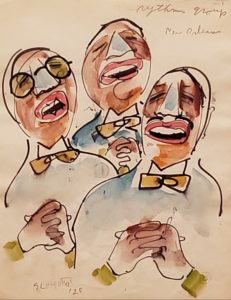Looking at the Collection
Stephen Longstreet: All that Jazz
Haws Gallery
March 22 – July 19

The Huntsville Museum of Art is pleased to present this exhibition of 27 works on paper by American writer and illustrator Stephen Longstreet (1907-2002), whose best-known drawings provide a chronicle of the dynamic and colorful world of jazz during the 20th century. The works were gifted to the Museum in 1985 by the artist himself, and are displayed together here for the first time. 
Born in New York City, Longstreet grew up in New Brunswick, New Jersey, where he was introduced to ragtime and jazz by future singing legend Paul Robeson, then an All-American football player Rutgers University. Their friendship began in 1918, when Robeson spotted the 11-year-old Longstreet sketching him as he practiced dropkicking. In his 1986 book, Storyville to Harlem: Fifty Years in the Jazz Scene, Longstreet explained that Robeson made him “aware of the gap between the music taught on paper and the ‘razzmatazz’ sounds of the scratchy jazz recordings.”
While studying at the School of Fine and Applied Arts in New York in the late 1920s, Longstreet drew the musical scenes in Greenwich Village, the speakeasies, and the Cotton Club in Harlem. “I had hoped to capture with black marks on white paper, this music created by these people, and set down what they looked like, felt and did before they were gone,” he later wrote. Shortly thereafter, Longstreet was furthering his artistic studies in Paris, where he met Picasso, Matisse and other artists. He also met and drew James Joyce, and Gertrude Stein, and the American “jazzmen” who were, he later wrote, “escaping from Judge Lynch and the back of the bus.”
After returning to the United States in 1930, Longstreet traveled south to New Orleans, discovering the “strange and wonderful sounds” of jazzmen playing in Storyville, the city’s red light district, and capturing them in his work. He later drew and painted Count Basie, Sarah Vaughan, Billie Holiday, Duke Ellington, and other jazz greats. Of Longstreet’s depictions of the century’s jazz scene, Louis Armstrong wrote in 1971: “You want to feel the smell – the color – the great ‘OH MY’ feeling of the jazzmen, and stomp around in the smoke and dusk of the joints? Then you just go and locate some of the drawings and paintings of this cat Steve Longstreet and steal you a few.”
Not only did Longstreet sketch 20th-century jazz greats, he was noted an author and screenwriter. His career as a writer, which continued into his 80s, was as varied as it was long. He wrote detective novels, radio scripts, served as a film critic for the Saturday Review, wrote syndicated book reviews, and wrote scripts for Hollywood films in the 1940s and television shows in the ’50s and ’60s. A number of Longstreet’s books dealt with jazz, including Jazz From A to Z: A Graphic Dictionary, his 100th book, published in 1989.

